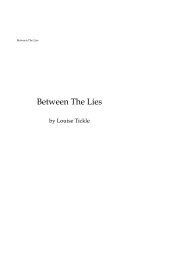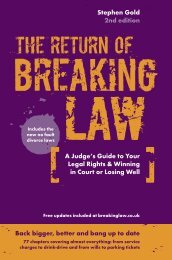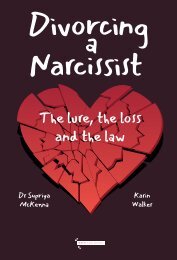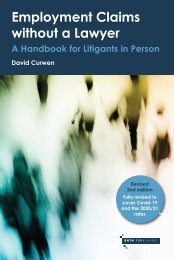Insolvency Made Clear: A Guide for Debtors
Plain English, practical guidance for anyone facing demands over a debt they are struggling to pay.
Plain English, practical guidance for anyone facing demands over a debt they are struggling to pay.
You also want an ePaper? Increase the reach of your titles
YUMPU automatically turns print PDFs into web optimized ePapers that Google loves.
Effect Of Bankruptcy<br />
Box 5:<br />
HOW MUCH OF THE HOUSE DOES THE<br />
BANKRUPT OWN?<br />
The starting point <strong>for</strong> a Trustee in Bankruptcy is that the Land Registry<br />
should say who owns what percentage of a house: <strong>for</strong> example,<br />
whether a husband and wife own the property 50:50, or if there is<br />
some other division of interest. Unless the bankrupt and their family<br />
can produce evidence to the contrary, this will be the end of the<br />
analysis.<br />
However, it is possible that the Land Registry, which only reports the<br />
‘legal interest’, does not represent the beneficial interest. This would<br />
happen when the legal owner holds part of the house on trust <strong>for</strong><br />
someone else. This could be through some express declaration of<br />
trust; or when one party made a contribution to some or all of the<br />
purchase price, or payments towards the mortgage or upkeep of the<br />
house. The non-bankrupt partner should present a schedule of all the<br />
payments they have made in relation to the house to claim as large a<br />
proportion of the property as possible. They may need separate legal<br />
advice to help them demonstrate what their true entitlement is. In<br />
practice, a Trustee is likely to want to come to a settlement rather than<br />
litigate.<br />
2.3 Sale of the estate<br />
Under s306 of the Act, the bankrupt’s estate vests in the Trustee automatically,<br />
without any further <strong>for</strong>malities. This means that the Trustee can control the<br />
balance in the bank account, and has the power to sell property belonging to<br />
the bankrupt such as any valuable items like a television or car. If necessary, the<br />
Trustee can issue a warrant authorising the seizure of property, to break open<br />
premises, or to allow a police constable or officer of the court to search property<br />
not belonging to the bankrupt, but which contains important documents (s365<br />
of the Act).<br />
The sale of assets is one of the most important aspects of bankruptcy. Other<br />
than the exceptions discussed above, all property which the bankrupt owns is<br />
transferred to the Trustee in Bankruptcy to sell. This means that the Trustee has<br />
the right to physically remove property which the bankrupt otherwise has in<br />
their possession. The Trustee may decide that certain items are not worth the<br />
sales value. For example, they are unlikely to sell a collection of photo frames.<br />
However, this decision is <strong>for</strong> the Trustee to make, and the bankrupt has no<br />
direct say in the matter. Applications to challenge decisions of Trustees are set<br />
out in Chapter 8.<br />
17













